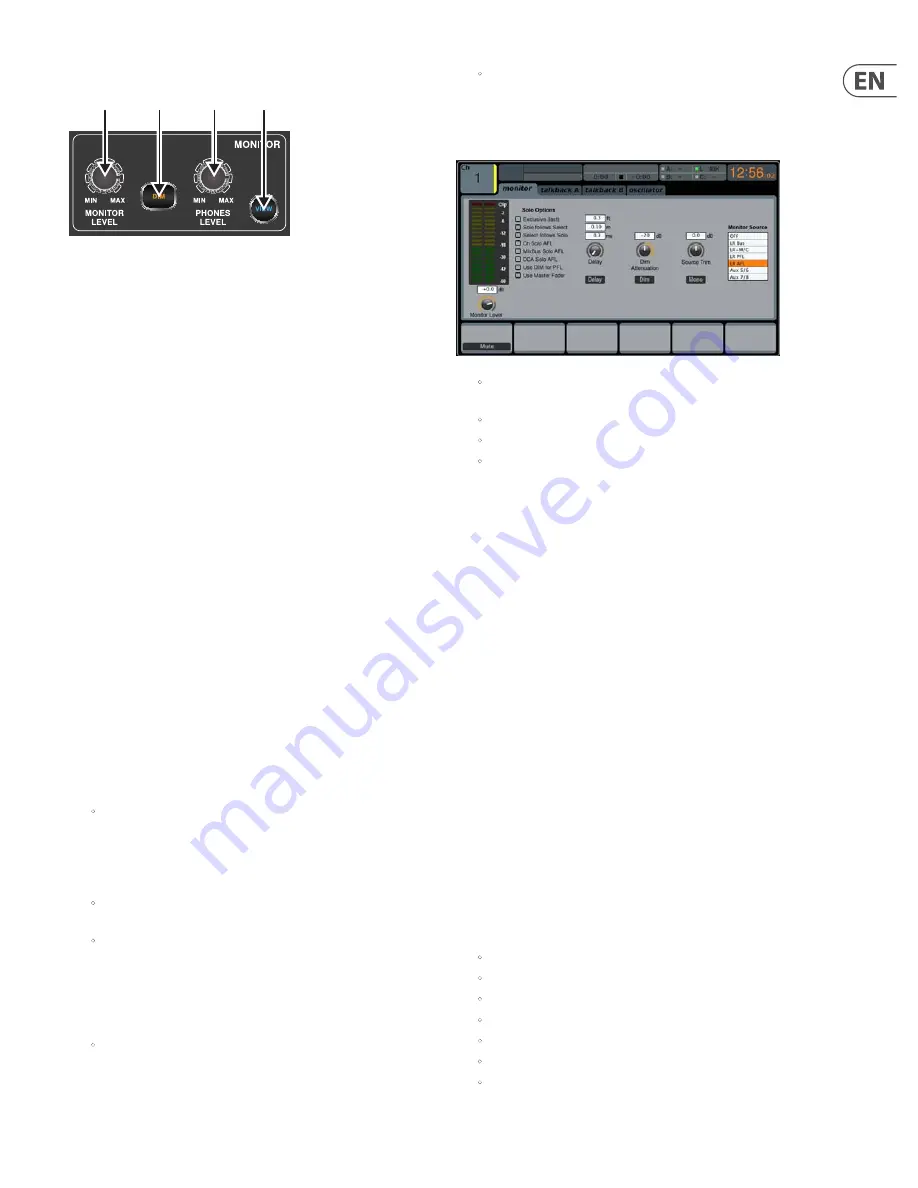
19
DIGITAL RACK MIXER M32R User Manual
1.10 Monitor
(1)
MONITOR LEVEL Rotary Control
Adjust the level of the monitor outputs with the
MONITOR LEVEL
rotary
control. This will be the output device connected to the sockets in the
MONITOR / CONTROL ROOM OUT
section on the rear panel.
(2)
PHONES LEVEL Rotary Control
Adjust the level of the signal through the headphones or other output
devices connected via the headphone jack sockets located under the front of
the console.
(3)
MONO
Press the
MONO
button to monitor the audio signal in mono.
(4)
DIM
Press the
DIM
button to reduce the monitor volume by a predefined
amount. The amount of attenuation can be defined via the Main Display
when the
VIEW
button is pressed.
(5)
VIEW
Press the
VIEW
button to access more detailed parameters on the
Main Display.
1.10.1
Operation
The
MONITOR
section shares a Main Display screen with the
TALKBACK
section.
On this screen, only the
monitor
tab contains functionality which relates to the
MONITOR
section. This tab controls various console options relating to the solo
bus, as well as the console’s control room outputs. These options include various
solo settings, speaker dimming, speaker delay, and a selection of sources for the
control room output.
To adjust the settings on the
monitor
tab, perform the following steps:
1. Adjust the first push encoder to change the gain of the monitor signal.
This digital stage occurs as a first preliminary level control, before the
top panel’s analogue-based monitor level control. A display above the
push encoder shows the currently set gain value in dB.
•
A multi-segment level meter is displayed on the Main Display to allow
for proper gain staging of the monitor signal.
2. Adjust the second push encoder to scroll through the various solo
methods available to the console when audio is routed to the solo bus.
Available options include:
•
Exclusive (last)
: In this mode, pressing another
SOLO
button
disengages the previous solo
•
Solo Follows Select
: When this method is selected, the audio of the
currently selected channel will automatically be sent to the solo bus.
Since a user will often select a channel to adjust its dedicated DSP
controls, this method is useful because the audio of the channel will
now already be feeding he solo bus where it can be monitored with
headphones in a live sound environment
•
Select Follows Solo
: When this method is selected, any channel that is
soloed will automatically become the currently selected channel
•
Ch Solo AFL
: The channel and select button do not have any correlation
to each other. When a channel’s
SOLO
button is pressed, its audio is sent
to the solo bus in ‘after-fader-listen’ mode, reflecting the current level
of the channel fader and any channel DSP that has been applied.
The default setting for input channels is off for ‘pre-fader-listen’.
•
MixBus Solo AFL
: Selecting this method will set the mix bus solo to
post-fader
•
DCA Solo AFL
: Selecting this method will set the DCA solo to post-fader
•
Use DIM for PFL
: Selecting this option will apply
DIM
to all PFL signals
•
Use Master Fader
: This allows the main fader/
MUTE
button to control
the solo/mon output.
3. Tap the second encoder to select and assign the currently chosen
solo option.
4. Turn the third encoder to adjust the amount of digital delay that is
applied to the control room signal path. The display on the screen will
show the current amount of delay in feet, metres and milliseconds.
5. Tap the third encoder to toggle the delay function on or off.
TIP:
The delay function is useful for aligning the sound of audio monitored
through headphones, or speakers used at front-of-house position with audio
that is coming from the stage location.
By delaying the control room audio, it can be brought into alignment with
the slightly-delayed audio that has to travel from the stage to the front-of-
house position.
6. Adjust the fourth encoder to set the amount of volume reduction
that occurs when the control room bus has its
DIM
function enabled.
The amount of volume reduction ranges from -40 dB to 0 dB
(no change).
7. Tap the fourth encoder to toggle the
DIM
function on or off.
8. Turn the fifth encoder to adjust the volume trim for the source currently
feeding the control room bus, allowing it to be level matched with the
SOLO bus. The amount of trim can be adjusted from -20 dB to +20 dB.
9. Tap the fifth encoder to toggle the control room between mono and
stereo operation. This is very useful in a studio context for checking how
a mix sounds when played back on a mono speaker such as a cock radio.
10. Adjust the sixth encoder to select what specific signal source to monitor
in the control room. Choices include:
•
Off (no source) in the control room, when no SOLO is active
•
LR Bus
•
LR + C/M
•
LR PFL (Pre-Fade Listen)
•
LR AFL (After-Fade Listen)
•
Auxiliary returns 5/6
•
Auxiliary returns 7/8 (USB Recorder).
11. Tap the sixth encoder to activate the signal source that has been chosen.
(1)
(2)
(3)
(4)
Содержание M32R LIVE
Страница 56: ...56 DIGITAL RACK MIXER M32R User Manual 4 3 Appendix C Dimensions Top View...
Страница 57: ...57 DIGITAL RACK MIXER M32R User Manual Rear View Side View...
Страница 67: ......






























